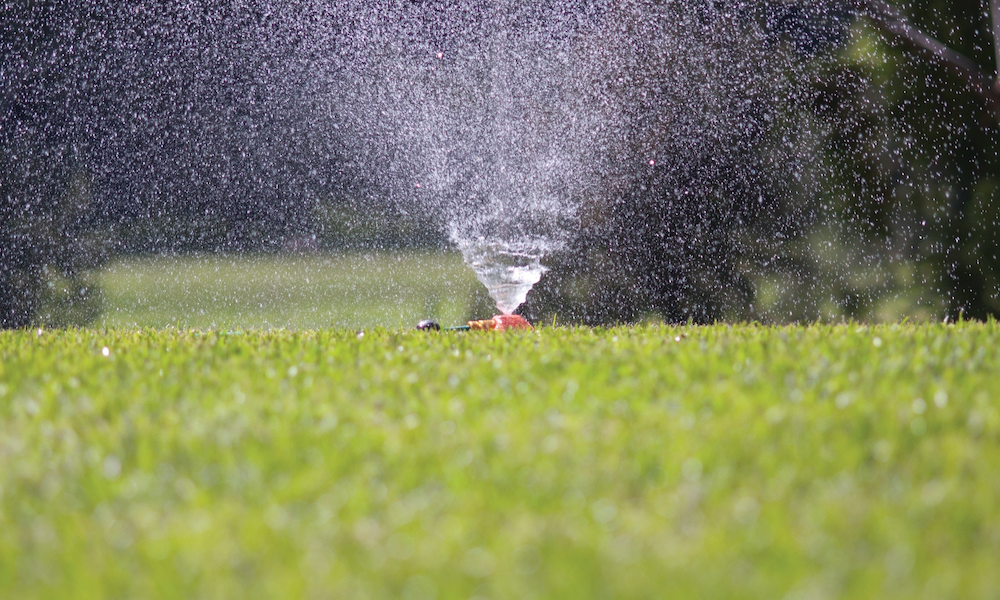
- Categories: LAWN CARE
Lawn Maintenance
Watering your lawn
All good lawn maintenance regimes include some amount of watering.
To ensure that the roots develop a deep root system well it is better to apply one deep watering in lieu of frequent shallow watering.
Water requirements for an established lawn are considerably less than what is required during the establishment period, particularly with Sir Walter as it has one of the lowest water requirements for any turf grass.
In an average Sydney summer you should apply 2-3 deep waterings a week and 1 per week in winter depending on conditions while the lawn is establishing.
Once the lawn is fully established in about 12 months, one deep watering of 15mm in summer should be sufficient each week – use a plastic container or rain gauge under the sprinkler to estimate how long it takes the sprinkler to apply 15mm.
Pro lawn maintenance tip: Avoid watering in the evening and at night as the lawn will remain wet and this can encourage fungus and disease – the best time to water is early morning when less water will be lost through evaporation.
Sydney Water has authorised drip irrigation systems to be used during times of water crisis.
Drip irrigation can be installed under lawns and the following important points should be considered:
- Drip emitters should be spaced no more than 30 cm apart
- “Rootguard” Drip Lines which contain a root inhibitor known as Treflan should be used to stop the roots of the turf from invading the drip emitters.
- Timers should be used to automatically switch off the irrigation as it is easy to forget that the system is on when you can’t see the drip emitters operating
- Drip emitters which discharge 2.3 Litres per hour spaced at 30 cm apart will apply 15mm of irrigation in 0.5 hours.
Mowing your lawn
For freshly laid turf, the roots should have established in about 14 days in warmer weather.
You can test this by lifting the turf slightly and the turf cannot be easily lifted – the first mow should be left until the grass blade length is about 60-70mm in length.
Mow along the turf rolls until you are satisfied that the lawn has established and then for subsequent mowings vary the cutting direction to promote evenness.
Make sure your mower blades are sharp to provide a clean even cut.
Generally speaking, most lawn varieties will become prone to weeds and drying-out if they are mown too low.
So it’s best to leave a little length to your grass and mow more frequently.
The general rule of thumb in lawn maintenance and mowing is never to remove any more than a third of the blade length in any single mowing.
The optimum mowing height for Sir Walter is between 25-40mm and should be left at approx.
50mm in shady areas. In winter it is advisable to increase the mowing height another 10-15mm.
Fertilising
Prior to laying, the soil should be fertilised and again two weeks after installing, then every eight weeks for the first twelve months.
Once established, apply fertiliser early spring, early summer and mid autumn.
The autumn fertilising is essential for the lawn to stay greener through winter.
Correct fertiliser recommendations vary depending on climate, region and soil type.
Generally a slow released balanced Nitrogen, Phosphorous, Potassium (NPK) lawn food is best, such as Sir Walter Fertiliser that is available from most Lawn Solutions Australia suppliers and can be purchased here.
Top dressing your lawn
Top dressing can assist in fixing unevenness or irregularities in your lawn.
Using lime and gypsum
Gypsum (calcium sulphate) enables more water, air & nutrients to penetrate a clay soil.
In this Sir Walter video Nigel Ruck explains how to use Gypsum to prepare for your new lawn, but also gives you tips on repairing an existing lawn.
Addressing lawn compaction
Is your lawn suffering from compaction due to heavy traffic and general wear and tear?
In the video below Nigel Ruck explains how to test for and easily address lawn compaction.







